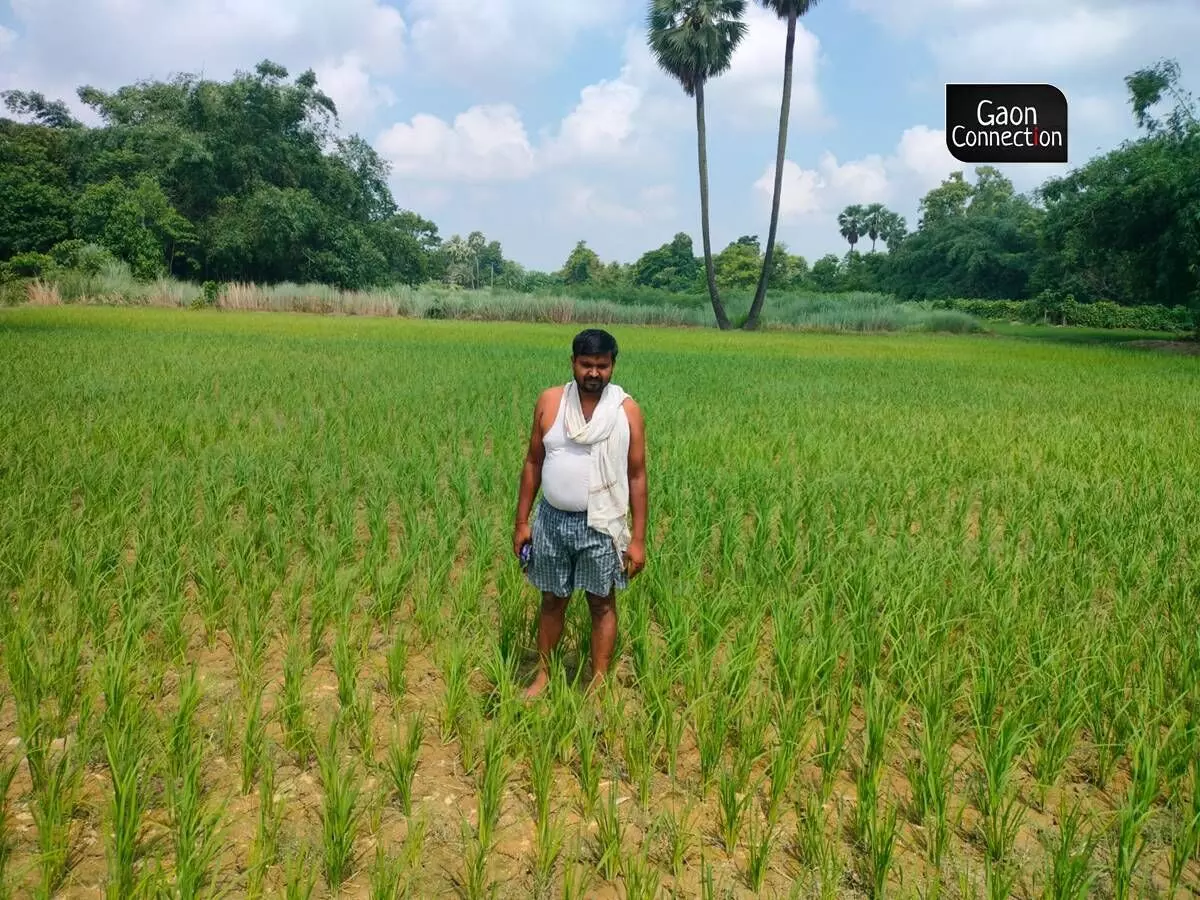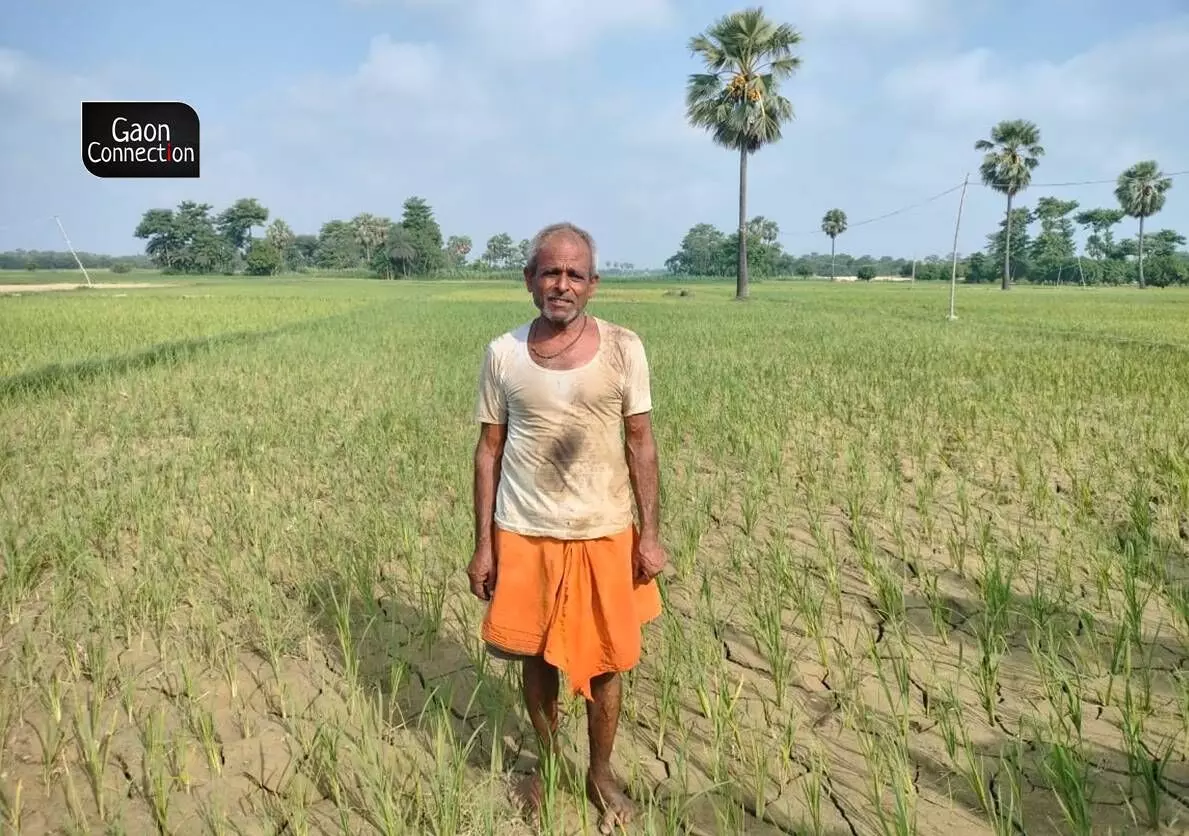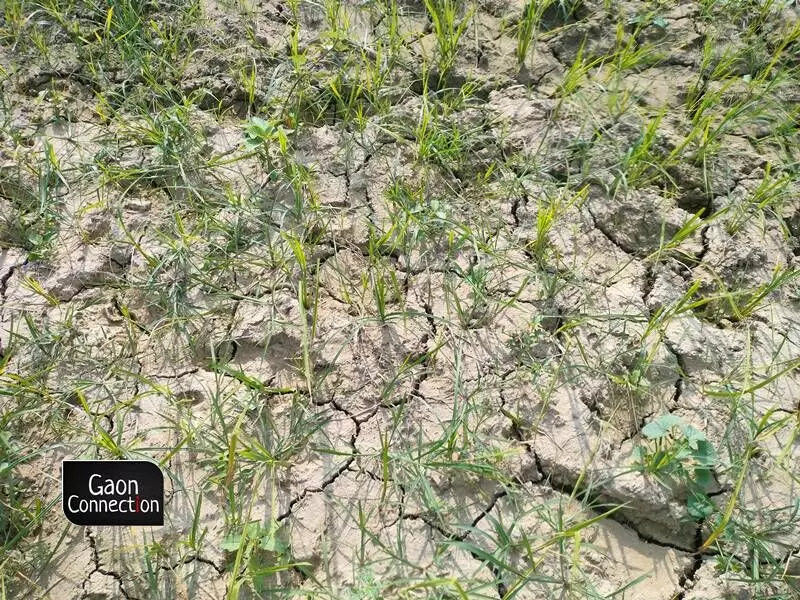Muzaffarpur/Sheohar, Bihar
Nitish Kumar Yadav owns 16 bighas of land in rural Bihar – that is 435,520 square feet. In a city, that would be area enough for four hundred and thirty five 1,000-sq-feet apartments.
But he won’t have rice to eat this summer.
“I had sown 16 bighas of paddy, thinking it would make up for my poor wheat harvest in the last rabi (winter crop) season,” said Yadav, from Belahi Lachchi panchayat in Muzaffarpur. “I was going to barter the paddy for wheat so that we would have enough rotis to eat.”
But it has barely rained this year in Bihar.
Irrigating their fields has now become a nightmare and farmers are helplessly watching the paddy saplings dry and wilt in the heat. The state may be heading into a drought.

Nitish Kumar Yadav poses for a photograph in his field.
“Now it looks like I won’t have rice to eat either,” Nitish Kumar Yadav said as he sat by a talaab (a pond) in his village, which is located over 70 kilometres north of the state capital Patna, hoping to get lucky with a catch.
Kumar, in his mid-30s, said he worked hard on his land no matter how hot it was (in June month, the state had heat wave warnings, and some deaths were reported too). He said that he had spent money on preparing his land for paddy and it was all for nothing, as now his crop withered where it stood.
Paddy becomes rice after the inner layer called bran and the outer layer called husk are removed through the processes of milling. Wheat is grinded to become flour for roti and breads.
Paddy is a primary monsoon crop as it is a water-intensive crop, and on an average, about 2,500 litres of water need to be supplied (by rainfall and/or irrigation) to a rice field to produce one kilogramme of rice. When monsoon fails, farmers are forced to extract groundwater through diesel pumpsets to irrigate their fields, which is an additional cost with diesel selling over Rs 95 a litre in Bihar.
The surroundings are eerily silent. Where once green paddy fields on either side of the road for five kilometres from his Belahi panchayat in Muzaffarpur district to Bariyapur in Sheohar district in north Bihar would be dotted with farmers, today there is hardly a soul.
Bihar has had scanty rainfall this year, affecting kharif (monsoon season) crops.
Two months of the southwest monsoon season are over and the state has reported a deficient rainfall of minus 48 per cent between June and July 30 this year, as noted by the India Meteorological Department (IMD).
Of the 38 districts in the state, only two (Buxar and Kishanganj) have had normal rainfall so far this monsoon. North Bihar region is considered India’s most flood-prone area but almost all the districts are facing drought conditions. The state had received deficient rainfall in the monsoon season last year as well.

Wheat first, then maize and now paddy, all three crops have failed and Shivaji Kumar, a farmer from Narwara village in Sheohar district worries about how he is going to support his family.
Not too far in the same village, 70-year-old Gagandev Rai’s paddy crop also craved water and died.
“I have watered my crops twice or thrice, have used fertilisers and pesticides to keep them healthy, but it has all gone,” he told Gaon Connection.
The severe water crisis is forcing farmers yet again to turn to a dangerous road and eke out precious groundwater.
Some 130 kilometres to the northwest Muzaffarpur, farmers in the state’s largest district of Pashchim Champaran are spending sleepless nights trying to organise diesel pumpsets to irrigate their paddy and maize fields using groundwater.
Of course, there is little money to afford the diesel as well.
“It costs us Rs 200 an hour to get our fields irritated through diesel pump sets. We have turned paupers trying to irritate our paddy and maize crops,” said Bacchu Sahni, a farmer from Naya Tola Bhishambharpur village in Pashchim Champaran.
His village is located next to the Gandak river, a tributary of the Ganges, but farmers are finding it hard to keep their kharif crops standing.
“धान और गन्ने की पटवन में हम बिका गए हैं”
[पटवन means irrigation]Desperate farmers in West Champaran are spending Rs 200 per hour to get their fields irrigated through diesel pumpsets. The crops are drying and dying due to lack of rains. A #drought looms over #Bihar. pic.twitter.com/jc0NtBFsUc
— Gaon Connection English (@GaonConnectionE) July 29, 2023
Districts such as Sitamarhi, Sheohar, Purba Champaran, Muzaffarpur have reported a rainfall departure of minus 83 per cent, minus 75 per cent, minus 70 per cent, and minus 65 per cent, respectively.
Wheat first, then maize and now paddy, all three crops have failed and Shivaji Kumar, a farmer from Narwara village in Sheohar district worries about how he is going to support his family.
“What will our children eat, how will I get medicines for them if they need it?” he asked. He said hundreds of farmers like him were in similar distress.
Shivaji Kumar had sown paddy on three bighas of land and not even one bigha has yielded anything for him. “No one cares about us, we have no one to turn to for help,” he told Gaon Connection.
Rs 100 crore diesel subsidy
The state government is not unaware of the challenging situation in the state. Last week, the state cabinet approved Rs 100 crore for giving diesel subsidies to farmers to irrigate their land in view of the drought-like conditions prevailing in the state.
According to the agriculture department, the government will provide a subsidy of Rs 75 per litre to the farmers. The farmers using pump sets for irrigating their lands will receive up to Rs 750 an acre. The money will be transferred directly into their bank accounts. Applications have started coming in for the subsidies.
“So far about 142 people have applied for diesel subsidy. If we get additional support from the state government, we will ensure the farmers get the benefits as quickly as possible,” Kamlesh Prasad, district agriculture officer, Sheohar, told Gaon Connection.

“We have already requested the government to provide the farmers who have not been able to cultivate anything on account of the heat and lack of rainfall, with arhar dal and other less water-intensive pulses for them to cultivate,” he added.
“About 4,700 farmers have applied for diesel subsidy in the district,” Rajan Balan, district agriculture officer, Muzaffarpur, told Gaon Connection. According to him, there are no other schemes from the government to tackle the drought conditions for now.
In Sitamarhi district, about 2,000 farmers have applied for diesel subsidy, said Brajesh Kumar, the district’s agriculture officer.
But the diesel subsidy may not solve the problem. It could instead accentuate the water crisis in the state.
“Single or a uniform intervention such as diesel subsidy might not achieve its intended objective because of the diverse ground realities. Strategies should be such that they address the challenge of delayed or weak monsoon in its entire complexity,” said Eklavya Prasad, founder of Megh Pyne Abhiyan, a non-profit that works on water and sanitation issues in Bihar.
Prasad explained that all the 38 districts of Bihar can be classified into four broad categories — flood prone, regular floods but also vulnerable to drought, drought prone, and extensively drought prone but face the risk of floods. “Thus, the potential for double hazards of drought and flood should be considered when planning any intervention,” he said.
For now, none of that matters to Bihar’s farmers, battered by the climate, failure of agriculture and governance lapses.
“Without water, how do we grow crops and feed our families?” asked Chandmati Devi, a batai farmer (share-cropper) from Naya Tola Bhishambharpur.
“The gods seem to be angry with us.”
Bihar’s most flood-prone region is facing severe drought conditions. Poorest of the poor farmers, who depend on share-cropping (बटाई), are losing paddy which they had just sown. This farmer from Naya Tola Bhishambharpur, West Champaran, shares their pain.
: @JamwalNidhi pic.twitter.com/IScIe6H1zS
— Gaon Connection English (@GaonConnectionE) July 29, 2023



















